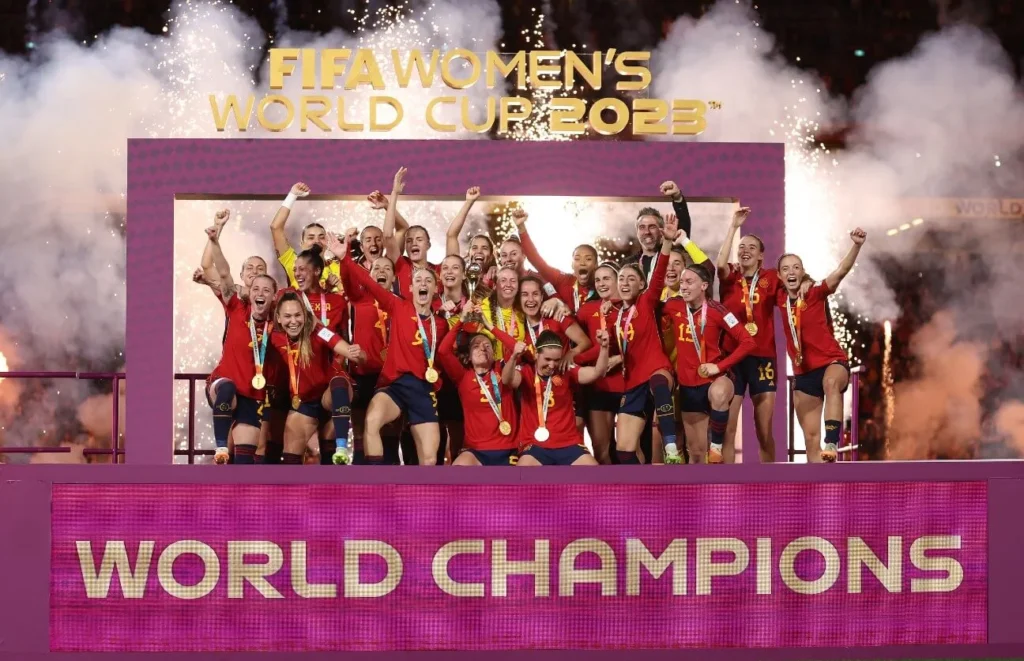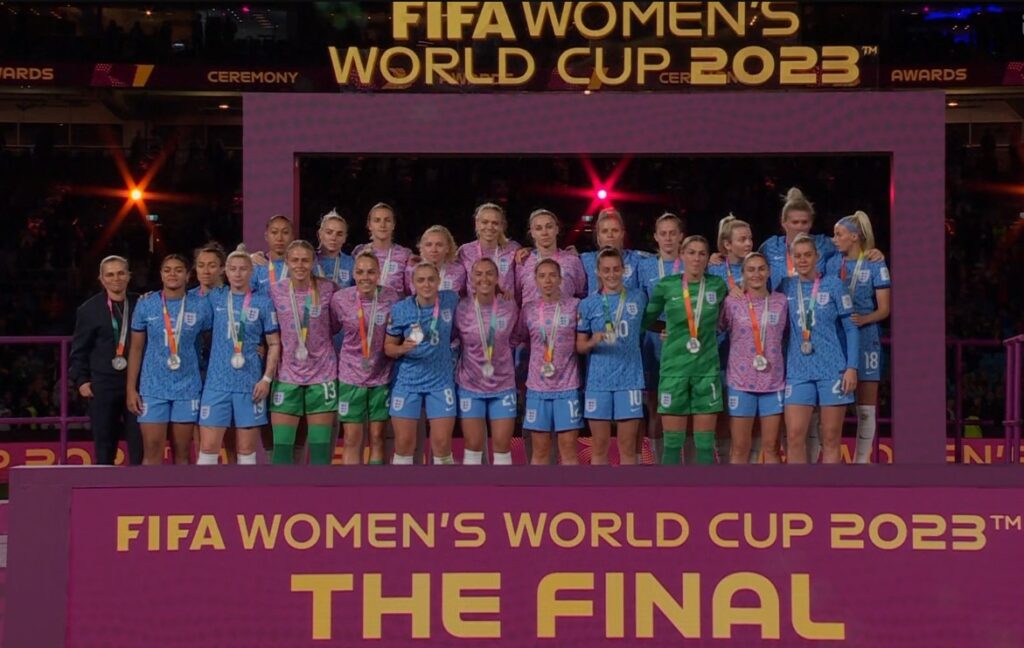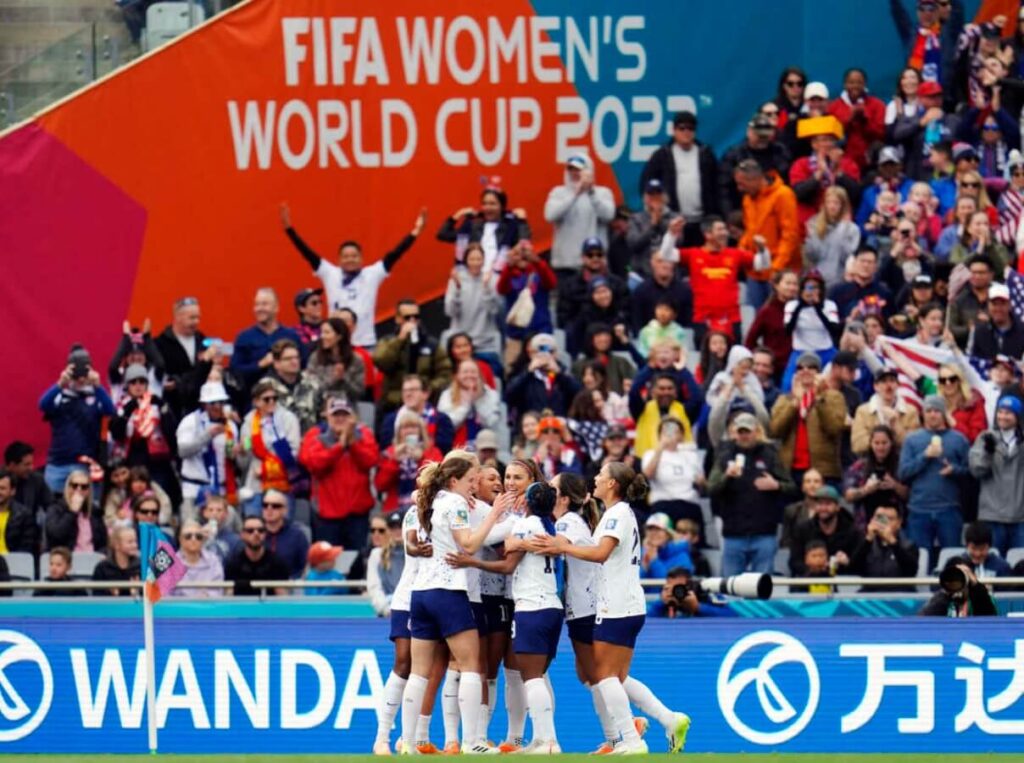
Spain’s ascent to the pinnacle of women’s football was nothing short of remarkable, marking a transformational journey filled with resilience, strategy, and sheer talent. In this analysis, we’ll delve deep into the defining moments and key players that propelled La Roja to their maiden Women’s World Cup title.
The Turning Point: Olga Carmona’s Decisive Goal
In a riveting face-off at Stadium Australia, Spain etched their name into football history books, securing their first Women’s World Cup title by overpowering England with a 1-0 victory. The spotlight was undeniably on Captain Olga Carmona, whose prowess ensured the solitary goal of the match during the initial half.
Overcoming Challenges: Spain’s Remarkable Journey
The path to victory was fraught with obstacles for the Spanish team, known affectionately as La Roja. Just a few months prior, the team had faced internal strife due to disagreements with their coach, Jorge Vilda. Adding to the adversity was their 4-0 thrashing at the hands of Japan in the group phase. Yet, their determination was evident in their match against England, as they showcased a performance worthy of a championship title.
“It’s the best feeling of my life,” an emotional Hermoso remarked post-match. “We played the football we wanted to, but I still think we are not aware of what we have achieved.”
The Game’s Key Players
Behind every monumental victory in the world of sports, there’s a cohort of athletes whose exceptional skills and tenacity set them apart. As Spain clinched their first Women’s World Cup, a few names undeniably stood out, orchestrating plays and making decisive moves. In this segment, we shine a spotlight on these game changers who turned the tide in Spain’s favor.
Spanish Dominance:
- Aitana Bonmati & Teresa Abelleira: This midfield duo was the backbone of the Spanish offense, controlling the game’s tempo and creating chances.
- Jennifer Hermoso: Although her penalty attempt was thwarted by England’s goalkeeper, her presence was a continuous threat to the English defense.
England’s Resistance:
- Mary Earps: The English shot-stopper showcased her skills, denying Spain a wider margin of victory with her crucial saves.
- Lauren Hemp: The forward showed her mettle, especially with her near goal moments in the first half.
Match Highlights
Spain’s intent to claim their maiden title was clear, with Carmona consistently overlapping down the left, creating opportunities. Their efforts were rewarded when England lost possession, setting up a cross-field pass to Mariona Caldentey. Carmona received the subsequent forward pass, and with precision, sent the ball beyond Earps, marking the game’s only goal.
England, however, had their moments, with Hemp almost finding the net in the early minutes and later hitting the crossbar.

The Tactical Shift: Coaches at Play
Jorge Vilda’s unwavering strategy paid off, with Spain sticking to their gameplay throughout the match. In contrast, England’s Sarina Wiegman, seeking to reverse her team’s fortunes, made tactical adjustments, switching from a three-player defense to four post-intermission.
Vilda, reflecting on the victory, said: “What we did, it’s difficult to achieve. Very proud of this team, we have shown we know how to play, that we know how to suffer, we have believed and we are world champions.”
Climactic Moments and The End Game
With Spain continuing their onslaught, Bonmati’s long-range shot ricocheted off the bar, intensifying the game’s tension. Spain’s plea for a penalty against Keira Walsh, after being reviewed by VAR, was granted. However, Hermoso’s attempt met with a superb save from Earps.
In the game’s dying minutes, England launched a final offensive, pulling all their players forward. Yet, Spain’s Cata Coll confidently intercepted the ball, sealing their historic victory.
England’s Perspective: A Missed Opportunity
The defeat was a poignant one for England, who had previously showcased their dominance in the football world. It marked only their second loss in 39 fixtures since Wiegman’s appointment as head coach.

Dive into the Numbers: Unraveling the 9th Women’s World Cup by the Stats
As the dust settles on the thrilling Women’s World Cup co-hosted by Australia and New Zealand, there’s an array of numbers that help encapsulate the sheer magnitude and historic elements of this tournament. Delving deep into these statistics not only reveals the grandeur of the event but also the staggering achievements and milestones that were reached.
Overview of the Tournament:
- Total Matches: 64
- Participating Teams: 32
- Hosting Venues: 10 across nine distinct cities
A Tournament of Records:
- Goals Galore: The net was rustled 164 times, setting a new benchmark for the highest number of goals in any edition of the World Cup.
- Spotlight on Penalties: A total of 27 penalties were awarded, excluding those from shootouts.
- Golden Boot Winner: Japan’s prodigious Hinata Miyazawa took home the accolade with her tally of five goals.
- Lightning Strike: Panama’s Marta Cox didn’t wait long to make her mark, netting a goal against France just 68 seconds into the match – the quickest of the tournament.
- High Scorers: Spain emerged as the highest-scoring team, amassing an impressive 18 goals.
- Most Dominant Display: The Netherlands showcased their prowess with a staggering 7-0 triumph over Vietnam during the group stage.
Players and Milestones:
- Prodigious Talent: South Korea’s Casey Phair became the youngest player to ever grace the World Cup, taking to the field at just 16 years and 26 days.
- Top Goal Honors: The fastest goal of the tournament was a mere 68 seconds into a match, credited to Panama’s Marta Cox against France.
The Financials:
- Victory’s Spoils: Spain, as the winning team, took home a hefty $4.29 million.
- Cumulative Prize Pool: The tournament boasted a whopping total prize pool of $110 million.
In the Stands:
- Peak Attendance: Stadium Australia in Sydney saw the highest footfall, with 75,784 spectators packing the stands for four games at full capacity.
- Tournament-wide Footfall: Nearly two million fans (1,978,274 to be exact) were in attendance throughout the event.
- Average Turnout: The tournament averaged an attendance of 30,911 per match. To put this in perspective, this figure is more than 9,000 spectators higher than the average attendance for the 2019 edition in France, which had a smaller team pool of 24.
In sum, this edition of the Women’s World Cup was not just about the football on display but also the historic and record-breaking numbers that will be etched into the annals of the sport’s history.
































